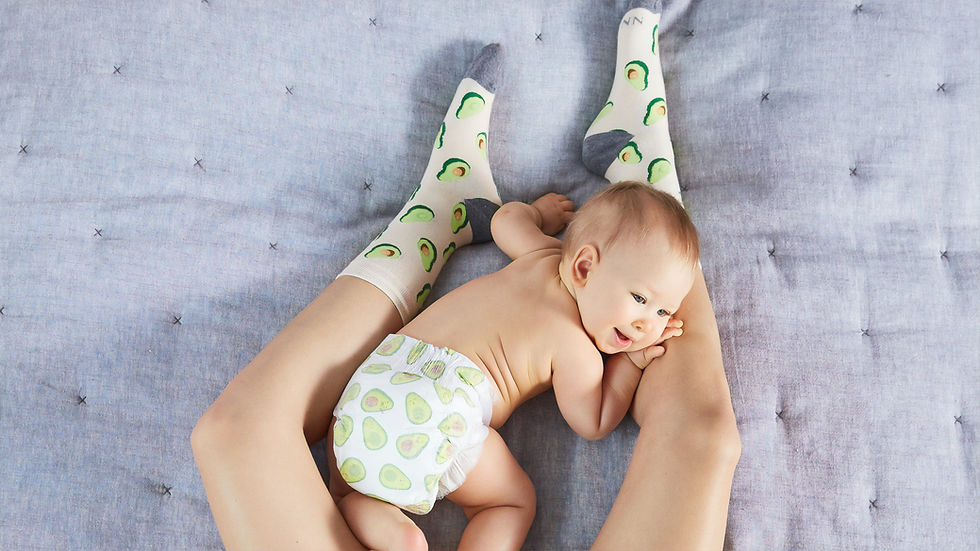Reusable vs Disposable Nappies
- Bundlenjoy HQ
- Sep 22, 2019
- 3 min read

Series 4 : The environmental cost of reusable/cloth and disposable nappies
The bubba is on his/her way and the one essential kit that is universally required - diapers! We are in the middle of a global plastic crisis. Disposable nappies take around 500 years to decompose but reusable nappies utilise lots of energy and water for their washing routine.
What is your take on it?
Do you have all the facts?
What does it mean?
An estimated 3 billion disposable nappies are thrown away every year in the UK, accounting for 2-3% of all household waste. From birth to potty, a baby gets through an estimated 5,500 disposable nappies as compared to 20-30 reusable nappies. Disposables take 500 years to decompose - let's put it into context; if Henry VIII used disposable nappies as a baby, his nappies are still around today! But we now know that the 'environmental impact' is so much more than just the landfill - let's have a look at the production cost of both types of nappies, together with its impact when it is discarded.

Manufacturing Disposables
- Mostly made from plastic and wood pulp7 million trees cut down in the UK/year to make pulp for single use nappies
- It takes one cup of crude oil to make ONE single use nappy
- Manufacturing enough single use nappies a week = 1,550L of water (which contains chlorine for bleaching pulp and dioxins - these go into our seas)
Manufacturing Reusables/Cloth
- Most made from a waterproof PUL (plastic) shell cover and an inner absorbent material (cotton, hemp, bamboo blends
- .Prefolds/wool diapers are plastic free and more environmentally friendly
- Can be reused for subsequent children or sold on after your family is complete to cloth other babies
Biodegradable / Eco Disposables

Are they really biodegradable? No. They have elastic around the legs, velcro around the legs, SAPS (absorbent gels) - none which are biodegradable. Some parts are - some have an absorbent core made with wood pulp, or bamboo, both which are biodegradable. However all the back part of disposable nappies are made by a 'breathable' plastic so that the baby doesn't leakIn short, there is no 100% biodegradable nappy.
Electricity and Water Waste in Reusables

Washing 3 loads of nappies a week = 200L of water (vs 1,550L for disposables). Washing water from the washing machine is treated via the water treatment system and is pretty easy to deal with. Washing at 60 degrees and running a full tumble dry each time leads to loads of carbon emissions according to the Environmental Agency 2008 report; but this report is debunked here.
What does it mean for me?
There is so much to parenthood that perhaps thinking of the environment is not at the top of your priority list. We totally get it. All mamas want the best for their children. However, we only have one Mother Earth, so protecting the environment has to start somewhere. So how can you stay sane and environmentally friendly?
1. Mix and match using reusables and disposables. Even using one reusable saves a disposable from going to the landfill.
2. Line dry where possible and load your washing machine appropriately when using reusables. This reduces the electricity usage of washing and allows for a more efficient wash cycle.
3. You can recycle disposables - contact your council to check if they have nappy recycle schemes. However, do note that the plastics will need to be separated from the nappies first before it can be recycled; and this on its own is energy consuming.
4. Council nappy vouchers help with startup costs for reusables. Check if your council is part of the nappy voucher scheme here, and visit a local nappy library where nappies are given out for free or a small fee as a trial.
5. Reusable nappy laundering service - definitely a thing and you just need to research if your local area has this service! Be gone dirty nappies and come back to me freshly laundered!

Learn more about cloth nappies here :
and for the science-y, fact-loving mamas among you :
So are you ready to have a cloth bum baby?
Get set, ready.... CLOTH!


Comments